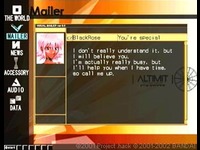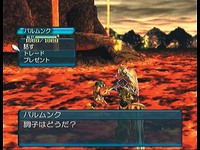|
|

|
PLATFORM
|
PS2
|
BATTLE SYSTEM
|

|
INTERACTION
|

|
ORIGINALITY
|

|
STORY
|

|
MUSIC & SOUND
|

|
VISUALS
|

|
CHALLENGE
|
Easy
|
COMPLETION TIME
|
Less than 20 Hours
|
|
OVERALL

|
+ Unique, captivating storytelling.
+ Original premise.
- Awful combat system.
- Ugly environments.
- Terrible AI.
- Final boss is drastically unbalanced.
|
Click here for scoring definitions
|
|
|
The year is 2010. Microsoft has (assumedly) fallen, after a deadly computer virus caused several people to suffer fatal seizures, their Windows operating system replaced by ultra-secure ALTIMIT. Blizzard's World of Warcraft has been toppled by "The World," a massively multiplayer RPG from CC Corporation that has quickly grown to service twenty million customers worldwide, easily shattering the previous record of eleven million. It is within this game that the .hack series takes place. .hack//Infection is the first of four games in the original quadrilogy, accompanying the anime .hack//SIGN and various other pieces across multiple media to tell the story of Kite, "The World," and the events that transpired within its boundaries.
The story of .hack is rather unique, as is its presentation. While each aspect of the multimedia series focuses its attention on different characters, the game series, beginning with Infection, focus on an unnamed eighth grader who goes by the moniker Kite within CC Corporation's popular MMO. Invited to the game by his real-world friend, going by the handle Orca, their first time grouping together ends tragically when the pair encounters a mysterious, white haired girl being pursued by an invulnerable monster. The creature performs an attack on Orca that destroys his character, and, as Kite soon learns, leaves his friend comatose within the real world. .hack//Infection follows Kite as he tries to figure out what happened.
.hack//Infection mostly serves as an introduction to "The World" and the other players who reside within it. Its story is surprisingly minimalistic, and while it serves as a good starting point, the real story is very obviously to come. Players may find themselves itching to learn more about what's going on within "The World," but sadly this installation of the game offers many questions, but few answers. The telling of the story, however, is what sets the .hack series apart from any other RPG on the market. Taking place entirely within the computer world, at no point during the game is anything real ever seen. Instead, the story makes use of its setting by telling it through a combination of traditional cutscenes, e-mail messages, message forum posts, and online news articles. This unorthodox method of storytelling is what makes .hack unique, and is far and away its strongest feature.
 .hack uses e-mail and web forums to help tell its story.
.hack uses e-mail and web forums to help tell its story.
|
|
Unfortunately, that's about the only thing that can be said for .hack//Infection. At the core of the game is quite simply one of the most atrocious action battle systems ever crafted. During battle, the player only has access to three commands, and two of them are menus, one for AI commands and another for battle commands such as skills and items. The other function provides a basic attack which is slow, delayed, and not particularly engaging, and it is sadly what players will be relying on for ninety percent of the game's combat. The most frustrating part of the whole affair is the lack of any hotkeys for special skills, which really breaks the flow of battle. Couple this with an awful camera, and the whole thing is just painfully frustrating.
It doesn't help, either, that the ally AI is excessively stupid. Characters will do almost nothing without commands from Kite, and this is particularly true for the Wavemaster characters, "The World's" mage and healing class. All the initial AI settings involve not using skills at all, which means the Wavemasters will stand around picking their noses until Kite tells them otherwise, not even healing without his go ahead. Melee classes aren't much brighter, either. The delay between their attacks is ridiculous, to the point where Kite has to kill everything pretty much by himself, his melee ally serving as little more than a distraction to keep a few enemies away from him.
Finally, game balance issues provide the triumphant cherry atop .hack's sundae of mediocrity. Specifically, enemy magic users are blatantly overpowered, not so much for the damage they deal, but how they deal it. All magic-toting enemies make a point of running away from Kite at breakneck speeds, forcing him to chase after them in a fruitless game of cat and mouse. Since Kite moves at the exact same speed as those enemies, getting attacks off against them relies on getting in front of them as they turn, or trapping them in a corner, made all the more difficult by the awful camera. The final boss fight is also drastically more difficult than anything else experienced throughout the game, which is likely to catch virtually all players by surprise.
The one interesting thing that the battle system has going for it is Kite's unique ability to "data drain" enemies. This special skill can only be used once the opponent has taken enough damage, but when it is performed, the enemy is reduced to a weaker state, often physically changing form as well. Using data drain can also have other effects, such as granting new equipment or "virus cores" which are used for unlocking certain story areas.
 This is just one of the many gaudy environments Kite is destined to encounter.
This is just one of the many gaudy environments Kite is destined to encounter.
|
|
Other aspects of the gameplay do provide for a bit more enjoyment, thankfully. There are numerous sidequests to partake in, including the raising of a grunty to ride on field maps. Grunties, for those not familiar with .hack's loveable mascot and this reviewer's forum avatar, are, as the game describes them, a sort of cross between a pig and a cow, and they are surprisingly endearing. The most enjoyable aspect of .hack, however, is the terrific game economy. Aside from purchasing consumables, most shops are effectively worthless. New equipment, instead, is best acquired by trading for it with other player characters in the game world. Different characters value different types of items, and all the junk and excess equipment that one acquires while traversing the game's many dungeons can be traded away for more powerful and useful items. While this system of bartering provides for a very different shopping experience than most RPGs offer, the true joy of it lies in discovering what's out there. Each player has a different stock of items to trade for, and the thrill of discovering a player who carries a powerful new weapon or piece of armor never gets old.
.hack//Infection arrived fairly early in the PlayStation 2's life-cycle, so the graphics aren't quite as impressive as what we've seen recently. However, even for their time, they were still lacking. The character designs and models are crisp and well-imagined, but the environments are simply abysmal. Aside from the root towns, which manage to be acceptably attractive, all the game's environments are built using a type of random generator. Players enter three keywords, acquired throughout the game, and it generates a dungeon based on the information contained therein. They aren't really random, as each keyword combination will generate the same dungeon every time, but it's still based on an algorithm. The end result is that ugly textures and bland dungeon design are overused throughout the game. There are no puzzles to solve or obstacles to overcome. If the dungeons were at least attractive to look at, they may have been tolerable, but unfortunately, they are ugly without exception.
On the plus side, the game does use several other effects to enhance the visuals quite effectively, and promote the idea that the player is playing an MMO. During his adventure, Kite will travel to many damaged areas, and within these areas, the textures are dissolving and the screen occasionally tears, making the area seem glitchy and unstable. Unfortunately, the dissolving textures are horribly overused, to the point where the player can distinctly see the same fragment on two sections of a wall simultaneously. The audio is vastly superior to the visuals. The soundtrack is good, and the game makes great use of sound effects. The voice acting is fairly weak, though not completely awful.
The only real reason to play .hack//Infection is its unique story, as the game has little else to offer. With this in mind and considering that the game wraps up in less than twenty hours, it's little wonder that gamers have long criticized the four-part series for being a money-drain. Now that the games have hit (and in most cases disappeared from) the bargain bins, those looking for a good, unusual story may want to give it a chance. In addition to the game itself, .hack//Infection also comes with a forty-five minute anime entitled .hack//Liminality. The first of four, Liminality provides an alternate view of the events of the .hack series — from the real world. .hack//Infection is a fairly poor game, but if you can put up with the terrible combat, the story can be very enjoyable.
Review Archives
|









